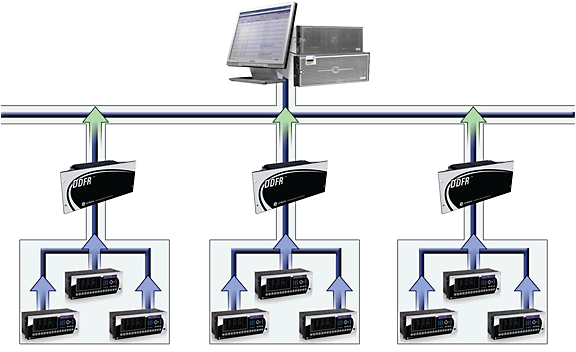
|
DDFR - Legacy
Distributed Digital Fault Recorder
Manufacturing for this product has been discontinued. As an alternative, please refer to the RPV311 or G500 The DDFR is a Digital Fault and Disturbance recording system that uses communications to retrieve Fault, Disturbance, and Sequence of Event records that are captured by the protection relays distributed throughout a substation. The DDFR internally stores this critical substation information for local station troubleshooting as well as archives this data in a remote enterprise network location for permanent storage and analysis. Key Benefits
Applications
Please note, the DDFR is now obsolete. Please view our latest portfolio of digital fault recorder. |
Data Recording
|
||||||||||||
|
||||||||||||
|
||||||||||||
|
||||||||||||
|
Key Features
Entreprise Network Archiving
The DDFR Archiving System will automatically copy all data stored in DDFR’s located throughout a companies wide area network into a centralized network location allowing users to analyze fault and disturbance data without having to be at the same location as the DDFR. This DDFR Archiving System that runs on coma network PC or Server can retrieve data from multiple DDFR’s thereby creating a permanent enterprise wide library of all past disturbances on your power system. The information collected by the DDFR Archiving System will be categorized in separate directories for each DDFR, making it easy for users to identify data about faults and disturbances related to each individual substation.

Archive data collected in DDFR’s distributed across the network into a centralized, accessible network location
Viewing Archived Records
Users can analyze sequence of Event Records, Transient Fault Records, and Disturbance Records that have been stored on a DDFR or archived onto a network location by the DDFR Archiving System by using the EnerVista DDFR Setup Software. The DDFR Setup Software’s Event Record viewer and COMTRADE viewer can access archived records to provide local or remote analysis capability to anyone with access to network storage location.
Sequence of Event Viewer
The EnerVista™ DDFR Setup Software contains a Sequence of Event viewer that allows for easy analysis of the Events stored in the DDFR or archived to the network location. Each recorded event will contain detailed information including:
|
|
The Sequence of Event viewer provides the ability to sort the recorded events by any of the available fields of information or to perform queries to show only the events that are necessary for troubleshooting a particular fault.
COMTRADE Viewer
The COMTRADE viewer that is included with the EnerVista DDFR Setup Software provides the ability of analyzing the Transient Fault Records and Disturbance Records that have been archived by the DDFR. This full featured COMTRADE viewer allows for analyzing records in a standard time based format that shows the magnitude of all measured quantities, or in Phasor diagram view that shows the magnitude and angle differences between any of the parameters. The COMTRADE viewer can also perform a harmonic analysis on all measured Phasor quantities and display the harmonic content for every point in the record up to the 25th harmonic.
Meet Standards DDFR Requirements
When used with advanced microprocessor based relays such as the UR family, the DDFR System meets or exceeds requirements of International Standards for Digital Fault Recording.

|